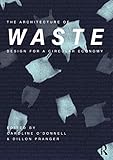Catalog - Resource Center for Learning and Research
Back to Site - CRAI LibraryThe architecture of waste : design for a circular economy / editores: Caroline O'Donnell y Dillon Pranger.
Contributor(s): O'Donnell, Caroline [editor.] | Pranger, Dillon [editor.]
| Pranger, Dillon [editor.] .
.
Material type:  TextPublisher: New York : Routledge, 2021Description: 367 páginas : ilustraciones.ISBN: 9780367247454.Subject(s): Arquitectura -- Aspectos ambientales
TextPublisher: New York : Routledge, 2021Description: 367 páginas : ilustraciones.ISBN: 9780367247454.Subject(s): Arquitectura -- Aspectos ambientales| Item type | Current location | Collection | Call number | Copy number | Status | Date due | Barcode |
|---|---|---|---|---|---|---|---|
| Libro (general) | Biblioteca Central UNIBE | General | 720.475 A673w (Browse shelf) | Ej. 1 | Available | 220528 |
Browsing Biblioteca Central UNIBE Shelves , Collection code: General Close shelf browser

|

|

|

|

|
No cover image available |

|
||
| 720.47 Y38r El rascacielos ecológicos / | 720.473 L886a Arquitectura subterránea : aproximación a un habitat natural / | 720.473 L886a Arquitectura subterránea : aproximación a un habitat natural / | 720.475 A673w The architecture of waste : | 720.68 T927g 2009 La gestión del proceso de edificación : | 720.9 A686c 1984 El concepto del espacio arquitectónico desde el Barroco a nuestros días / | 720.9 Ch546h 1978 Historia de la arquitectura / |
Introduction |
1. Global Circularity |
2. Waste of Space |
3. Case Studies |
4. New Deconstruction: The Rebirth of a Circular Architecture |
5. Economics for a Circular Environment |
6. World of Waste |
7. Afterword |
"Global material crises are imminent. In the very near future, recycling will no longer be a choice made by those concerned about the environment, but a necessity for all. This means a paradigm shift in domestic behavior, manufacturing, construction, and design is inevitable. The Architecture of Waste provides a hopeful outlook through examining current recycling practices, rethinking initial manufacturing techniques, and proposing design solutions for second lives of material objects. The book touches on a variety of inescapable issues beyond our global waste crisis including cultural psyches, politics, economics, manufacturing, marketing, and material science. A series of crucial perspectives from experts cover these topics and frame the research by providing a past, present, and future look at how we got here and where we go next: the historical, the material, and the design. Twelve design proposals look beyond the simple application of recycled and waste materials in architecture-an admirable endeavor but one that does not engage the urgent reality of a circular economy-by aiming to transform familiar, yet flawed, material objects into closed-loop resources. Complete with 300 color images and written for both professionals and students, The Architecture of Waste is a necessary reference for rethinking the traditional role of the architect and challenging the discipline to address urgent material issues within the larger design process"-- Provided by publisher.
Description based on print version record.
